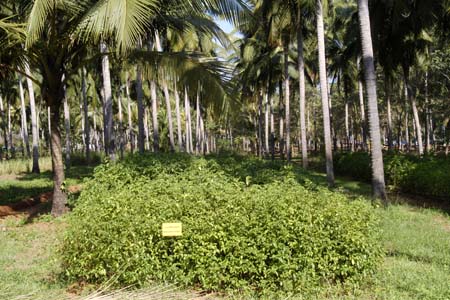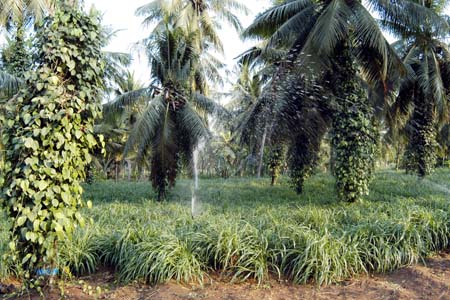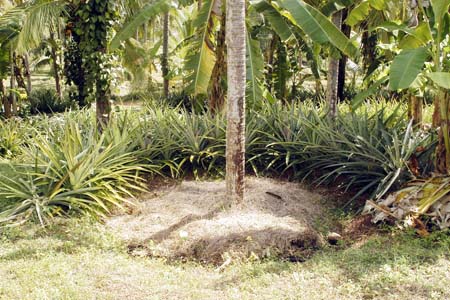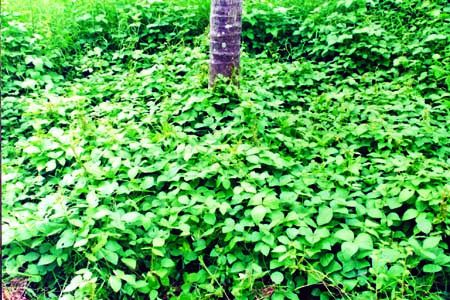Coconut
- Cultivation practices
- Nursery management techniques comprising selection of garden, mother palm and seed nuts, planting and maintaining the nursery, and the technique for raising polybag nursery were standardized.
- Square system of planting at a spacing of 7.5 x 7.5 m with a plant density of 175 palms/ ha is recommended for monocrop and coconut based cropping system.
- Nutrient management
- Recommended dose of fertilizer for coconut palm is application of Organic Manure @50kg/palm or 30 kg green manure, 500 g N, 320 g P2O5 and 1200 g K2O/palm/year in two split doses during September and May. Application of magnesium @500 g MgO per palm was found to be advantageous in areas where palms show yellowing of leaves (Coconut root (wilt) affected gardens) through soil application. However, soil test based nutrient application is recommended for efficient utilization of resources. In acid soils, for soil test values of more than 20 ppm, P application can be skipped.
- Fertilizer saving through drip fertigation i.e., 50% of the recommended dose of fertilizer when applied through drip fertigation is sufficient to give a yield equivalent to 100 % of the recommended dose of fertilizer. Fertilizers viz., 70 g Urea, 60 g DAP and 170 g Muriate of Potash is recommended for single application for one palm. A total of 7 applications is needed to apply recommended dose of fertilizer per palm through fertigation. For phosphorus application, commercial phosphoric acid can also be used.
- The critical boron level in soil and coconut leaves was standardized through techniques such as Cate and Nelson graphical (CN) method, the Mistcherlich equation (ME), and the quadratic plateau response (QP) method and it was 0.87 mg/kg in soil and 13.27 mg/kg in leaves.
- Application of 160 g borax per palm in four split doses along with husk burial in the basin and vermicompost application @ 20 kg per palm is recommended for correction of boron deficiency symptoms in coconut.
- Two nutrient mixtures ‘Kalpa Poshak’ and Kalpa Vardhini’ has been developed based on release pattern studies in the laboratory and evaluated in the field. Kalpa Poshak @ 100g per palm per year in two splits can be applied to the juvenile palms for enhanced growth and earliness in bearing. Kalpa Vardhini@ 500g per palm in two splits can be applied in adult bearing palms.
- A web based tool for computing soil test based nutrient recommendation was evolved and uploaded in CPCRI website :Go to site
- Recommendation developed for dwarf palms under integrated management for root(wilt) affected area: 100% soil test based nutrient requirement (STBNR- 530: 150: 1200 g N:P2O5:K2O/palm/year) along with raising and incorporation of cowpea in coconut basin, application of vermicompost and neem cake (@15 kg and 5kg/palm/year, respectively).This is ideal for dwarf palms meant for tender nut production.
- A Longterm fertilizer cum manurial experiment of 43 years of coconut cultivation revealed that soil exchangeable, lattice and total potassium status was higher with the regular fertilizer application compared to no manurial treatments. Moreover, reduction in lattice potassium status in no manurial treatments and slight reduction in non exchangeable potassium in fertilized plots also reveals that it is imperative to apply potassium according to the removal in order to reduce potassium mining and to sustain soil fertility and productivity in a long run.
- The technique for utilization of leguminous cover crops such as Pueraria phaseoloides, Mimosa invisa and Calopogonium species as green manures to supply biologically fixed nitrogen and easily decomposable biomass to coconut, to substitute 50 % nitrogen fertilizer, was standardized.
- Growing Glyricidia as green manure crop and using the biomass as green manure was found to be ideal for management of littoral sandy soils.
- Water management
- Application of 200 litres of water once in four days was recommended for irrigating coconut palms by basin irrigation method.
- Drip irrigation @ 66 % of the open pan evaporation (27 to 32 litres of water per palm per day under Kasaragod conditions) from December to May is ideally suited for coconut resulting in 34 per cent saving of water.
- Sprinkler irrigation or perfo irrigation with 20 mm (IW / CPE = 1) water was found to be the best suited to inter or mixed cropping systems where the entire surface requires wetting.
- Moisture conservation methods such as mulching with coconut husk, coir dust, coconut leaves, etc. in addition to application organic manures or green manures, intercrop cultivation, bunding, terracing, etc. are recommended.
- In sloppy terrains, trench filled with coconut husk, half moon bund, staggered catch pit reinforced with pineapple and growing CO3 grass across the slope, were proved successful in soil and water conservation.
- Surface runoff water harvesting and Roof water harvesting were successfully implemented and harvested water was utilised for irrigation.
|
|
- Cropping and farming systems
- Coconut based cropping systems involving cultivation of compatible crops like tubers, flowers, medicinal and aromatic crops, fruits, vegetables, spice crops, in the interspaces of coconut is economically superior to coconut monocropping.
- Coconut-based high-density multispecies cropping systems (HDMSCS) involving many crops like banana, pineapple, clove, and pepper was established.
- Application of 2/3rd of recommended NPK along with recycling available biomass in the farm of vermicompost resulted in sustainable yield in the system. The system provided a net income of Rs.3,50,000/- per ha/annum.
- Mixed farming system including coconut, dairy, poultry, rabbitry, sericulture, goats and pisciculture has been successfully demonstrated under Kasaragod condition. System provided organic manures for recycling, additional man power and additional income to a coconut farmer.
- Mixed cropping with CO3, CO4 and CO5 hybrid Napier fodder grass provided sufficient green grass to feed 5 to 7 cows from one ha coconut garden.
- Banana variety, Grand Naine, Elephant foot yarm (gajendra), pineapple, vegetables were found suitable intercrop for coconut gardens in littoral sandy soil with coir pith and husk as amendments.
- In root (wilt) affected area, Hybrid Bajra Napier Var. CO3 can be grown as intercrop in coconut garden (60% area) with integrated nutrient management including basal dose of 90:30:24NPK through fertilizers and subsequently through the recycling of organic inputs such as cow dung slurry (3750 L ha-1), vermicompost (2000 kg ha-1) after every cutting in two equal splits at fortnightly intervals (6 times a year) along with Azospirillum (3.5 kg ha-1) in a cost effective manner.
- Heliconia stricta ‘Iris’, H.bihai x H.caribaea ‘Kawauchi’, Heliconia stricta Sunrise and H. orthotropica ‘She’, are found to be suitable as intercrop in coconut plantations. A combination of varieties viz., ‘She’ and ‘Sunrise’ can be planted in 1:1 ratio for year round production of inflorescences. The coconut palms (Disease Early and Middle) 11-17 % increase in yield in three years time, wasmainly due to complimentary use of resources by both crops and improved microclimate.
- Heliconia stricta ‘Iris’ can be recommended as an intercrop during early stage in coconut plantations where the light intensity is low (30 to 35%) for improving the livelihood of farmers.
- Alpinia ‘Jungle King’ is suitable for intercropping in coconut gardens. It produces flower throughout the year except during April-May. The inflorescences produced in these plants were of marketable standards with more than 1 meter in length and spike circumference of 20cm.
- Tagetus-Gomphrena sequential cropping (30% area) under coconut based farming system in coastal humid tropics fetches year-round income from the system with a BCR 2.6
- Papaya (Carica papaya L.) is an ideal intercrop occupying 40% area, which can generate sufficient income to the farmer from very early stage of cultivation. At an average return of Rs.12/kg, the gross income from the system comes to Rs.3,60,000/- . The net return was about Rs. 2,34,000/- per hectare basis.
- Different medicinal crops like Aloe vera, Asparagus, Swertia, Aswagandha, Mentha were planted as intercrop in coconut plantation to find out the total system productivity. It was found that cultivation of medicinal crops under these systems helped to increase the system productivity. Maximum system productivity (8.62 t copra/ha) was recorded in coconut and Asparagus system followed by coconut + Aloe vera and Coconut Rawalfia over coconut as monocrop 2.8 t copra/ha).
|
|
- Bioresources management
- The technology for vermicomposting of coconut palm wastes by using a local earthworm, Eudrilus sp., closely related to the African night crawler, was standardized.
- Multiplication technique for the local Eudrilus sp. of earthworm using 1:1 cow dung-decayed leaves mixture was standardized and the earthworms are being distributed to the farmers to initiate vermicomposting.
- Production of vermiwash from coconut leaf vermicompost has been standardized and its beneficial impact on crop growth is being assessed.
- Utilization of coconut wastes for oyster mushroom cultivation (P. florida, P. sajor caju, P. flabellatus, P. opuntia and P. eous) was found to be economically feasible.
- Beijerinckia indica, Azospirillum spp., Burkholderia sp., Azoarcus sp., etc. were effective bioinoculants for better establishment of nursery seedlings.
- Four coconut PGPRS - P. putida KnSF 208, B. coagulans RSB 14, B. megaterium TSB 16 and B. megaterium TEB 2 and four cocoa PGPRs - P. putida KDSF 23, B. licheniformis KGEB 16, B. cereus ASB 3 and B. subtilis VEB 4 gave the highest increase in planr growth parameters. All the eight isolates have been identified using biochemical, BIOLOG and molecular based procedures.
- Developed organic farming practices for coconut to achieve coconut yield of over 100 nuts per palm per year with recycling of farm wastes, application of nitrogen fixing legumes and biofertilizers.
- A farmer-friendly methodology for mass-multiplication of bioinoculants was developed. The medium comprises of mature coconut water+rice gruel and minute quantities of coconut waste biochar. Using a pressure-cooker, the bioinoculant can be mass-multiplied using above liquid medium for immediate use by the farmers.
- The efficiency of vermicomposting of coconut leaves can be enhanced by employing a bio-shredder for pulverizing coconut fronds including their hard petioles. Using this method, vermicomposting of pulverized substrate can be successfully completed in one cycle (90 days) with 80-85% conversion efficiency as compared to the conventional method of chopped leaves in basins as well as in large tanks.
- A ‘push-pull’ strategy based simple and economical method for harvesting of earthworms from coconut leaf vermicomposting tanks has been developed. The method minimizes labour requirement and involves pushing of the earthworms by mustard solution and attracting them using cow dung mixed with other agro-wastes
- A coconut leaf vermicompost + coir-pith compost +PGPR based soilless medium was successfully formulated for raising healthy seedlings of cocoa and arecanut. This technology will help sustainable nursery management for agri-horti agencies.
- A next-generation sequencing based metagenomic analysis of the different stages of the unique coconut leaf vermicomposting process and the earthworm gut microbiota was analyzed. The complete bacterial diversity and its functional attributes were deciphered.
|
      |
Arecanut
- Cultivation practices
- Nursery management techniques comprising selection of garden, mother palm and seed nuts, planting and maintaining the nursery, and the technique for raising polybag nursery were standardized.
- A spacing of 2.7 X 2.7 m is found to be optimum for the growth of arecanut crop.
- Nutrient management
- Recommended fertilizer dose for arecanut is 100g N, 40g P₂O₅ and 140g K₂O / palm / year. However, soil test based nutrient application is recommended for efficient utilization of resources.
- With respect to optimization of fertigation dose and frequency, 50% and 75% of the standardized fertilizer dose is sufficient for pre-bearing and bearing arecanut palms, respectively through drip fertigation.
- Fertigation of 75% NPK at 10 days interval was highly profitable with highest net returns per rupee investment of 4.57 followed 75% NPK through fertigation at 20 days interval (4.44).
- Total uptake of macronutrients by arecanut was in the order of N > K > Ca > P > Mg. The order of total uptake of micronutrients was Fe > Mn > Cu > B > Zn.
- Optimum foliar concentrations for N, P, K, Ca and Mg were established as 2.70, 0.23, 1.12, 0.61 and 0.20%, respectively. Optimum micronutrient concentrations (mg kg-1) were estimated at 146 for Fe, 56.5 for Mn, 2.6 for Cu, 45.8 for Zn, 39.5 for B, 432 for Al and 63 for Na.
- Optimum soil nutrient limits were higher for laterite soils in arecanut tract than generalized guidelines for interpretation of soil analysis data. At 0-30cm soil depth, optimum nutrient concentration for P, K, Ca, Mg, Fe, Mn, Cu, Zn and B was established as 15, 192, 925, 179, 37, 88, 26, 5.5 and 1.4 mg kg-1, respectively.
- Nutritional disorders like crown choking, crown bending and oblique nodes in arecanut are due to deficiency of zinc and zinc deficiency in arecanut may be the result of complex interactions between DTPA extractable Zn and other nutrients in soil.
- In 12 year old arecanut (cv. Sreemangala), total biomass production was significantly greater in high yielders (43.6 kg palm-1) than in low yielders (30.8 kg palm-1). Trunk biomass accounted for 69% of the total biomass in high yielders and 74% in low yielders indicating less partitioning to other parts.
- Water management
- Irrigation with 200 litres of water per palm once in 6 days through hose is recommended.
- Drip irrigation @ 20 liters of water per palm per day results in 45% yield increase and 44% saving in water in arecanut.
- Cropping and farming systems
- Intercropping of MAPs in arecanut increased the productivity per unit area by 272 to 1524 kg ha-1. This amounted to the total system productivity of arecanut + MAPs intercropping system to the tune of 2990 to 4144 kg ha-1 while the average sole arecanut yield was 2795 kg ha-1.
- The net return per rupee investment was highest in Cymbopogon flexuosus (4.25) followed by Bacopa monnieri (3.64), Ocimum basilicum (3.46) and Artemisia pallens (3.12).
- On the basis of yield, quality and economic feasibility, recycling of gliricidia prunings from standards and vermicompost application alone or in combination with husk mulching are better options for intercropped vanilla in arecanut.
- Growing of vanilla on gliricidia standards did not affect the arecanut yield and the average kernel yield of arecanut during the experimental period was 3114 kg ha-1.
- Different medicinal crops like Aloe vera, Asparagus, Swertia, Aswagandha, Mentha were planted as intercrop in arecanut and coconut plantation to find out the total system productivity. It was found that cultivation of medicinal crops under these systems helped to increase the system productivity. More system productivity was recorded in all combination. Maximum system productivity 8.77 t/ha chali was recorded in arecanut and Asparagas combination followed by arecanut and Aloe vera (7.22 t chali/ha) and arecanut and Rawalfia combination (6.22 t chali/ha) over arecanut as monocrop (3.82 t chali/ha).
- Different arecanut based cropping system Models were tested to find out the total system productivity of the systems. It was found that Model II (Arecanut+ Black pepper+ Acid lime + turmeric) had maximum total system productivity (10361 kg/ha) followed by Model-I (Arecanut + Black pepper+ Acid lime + Banana) with a total system productivity of 9355 kg/ha.
- Among the different inter/mixed crops it was found that Black pepper contributed maximum (55-60%) on total system productivity where the main crop arecanut contributed only 29-36 % on total system productivity. Cultivation of inter/mixed crops in arecanut system is highly profitable as there was 224-334% increase of total system.
- Bioresources management
- The yield levels of arecanut can be sustained at around 2600 kg ha-1 due to organic waste recycling. However, the response of arecanut to chemical fertilizers was more pronounced as the yield increase was 73-85% with NPK application compared to VC application alone (48-59%) and integrated treatments (46-63%) over control.
- In arecanut based high density cropping systems having component crops like cocoa, pepper, banana and clove, comparatively similar yield levels and soil nutrient status was noticed with OMR and integrated use of chemical fertilizers and OMR. The result emphasizes that the system can be self-sustainable over a long term period. Application of N and P through inorganic fertilizers could be reduced or skipped, while the system proved exhaustive with regard to the availability of K.
- Vermicompost maintained higher SOC, soil test levels of P, Ca, and Mg than chemical fertilizers. Depletion of soil available K and accumulation of micronutrients was noticed in arecanut basins with vermicompost.
- A coconut leaf vermicompost + coir-pith compost +PGPR based soilless medium was successfully formulated for raising healthy seedlings of cocoa and arecanut. This technology will help sustainable nursery management for agri-horti agencies.
|
  |
Cocoa
- Softwood grafting is the most successful propagation technology
- Canopy architecture by pruning and planned cutting of branches have been standardized for canopy management under intercropping and in sole crop
- Cocoa is planted at a spacing of 2.7m x 5.4m in pits of 60 cm3 filled with compost in areca garden planted at a spacing of 2.7m x 2.7m with provision of shade.
- When cocoa is to be raised as a mixed crop with coconut, cocoa can be planted at 2.7 m apart in single hedge system and 2.5m apart in paired rows in double hedge system between two rows of coconut palms.
- The crop is to be irrigated once in a week during November-December, once in 6 days during January-March and once in 4-5 days during April-May with about 175 liters of water.
- Systematic study for 10 years on drip irrigation and fertilizer requirement of cocoa mixed cropped in arecanut revealed that drip irrigation at E0 of unity (20 liters of water per day per tree) and a fertilizer dose of 100: 40: 140 g of N, P2O5 and K2O per tree per year would be optimum for cocoa.
|
  |
Remote sensing and GIS applications
- To implement site specific soil management of coconut, spatial information on the soil constraints are imperative. In this line, soil constraint maps for coconut cultivation on the relatively permanent soil properties like soil depth, texture, drainage and soil reaction properties were prepared for the entire Tamil Nadu.
- Micronutrient status of major states and districts growing coconut, arecanut and cocoa crops were developed using the secondary sources.
- Using Remote Sensing and GIS map, coconut plantation area and coconut root (wilt) disease affected coconut palms were identified with > 98% accuracy.
|
|
Carbon sequestration potential
- Carbon sequestration potential of coconut, arecanut and cocoa were determined and the values were 8 to 32 t CO2/ ha/ year in coconut, 5.14 to 10.94 t CO2/ ha/ year in arecanut and 2.02 to 3.89 t CO2/ ha/ year in cocoa depending on cultivar, agro-climatic zone, soil type and management practices.
- Studies in arecanut - cocoa cropping system revealed that it is possible for carbon sequestration to the tune of 7.16 t/ha to 14.83 t/ha annually.
|
|
















